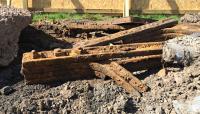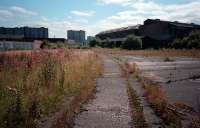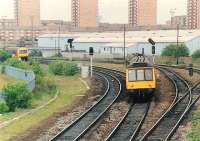Port Dundas Branch (Edinburgh and Glasgow Railway)
Introduction
This short largely single track branch was important as it served a mineral depot, two goods yard, distillery, power station, canal basin and brewery.
Dates
| / /1989 | Edinburgh and Glasgow Railway Bridge which carried the Port Dundas Branch (Edinburgh and Glasgow Railway) over Springburn Road to Port Dundas Basin dismantled. |
Portions of line and locations
This line is divided into a number of portions.
Cowlairs to Port Dundas
This junction was formed in 1992 with the opening of the south to east curve of the Cowlairs Chord (British Railways). The chord provides direct access to Cumbernauld for trains from Glasgow Queen Street High Level, formerly commencing from Springburn with a connecting Milngavie-Queen Street Low Level-Springburn shuttle. The original Edinburgh and Glasgow Railway is ...
More detailsSee also
Edinburgh and Glasgow Railway
Cowlairs Chord (British Railways)

Colin McDonald 22/02/2016
This mineral yard was on the west side of the Edinburgh and Glasgow Railway's Cowlairs Incline. Approach was from the north (giving the appearance of three tracks on the incline) with the connection to the main line at the south end of Cowlairs station. The sidings fanned out on the east side of Keppochhill Road.
...

Ewan Crawford //1987

Martin MacGuire 22/04/2016

Ewan Crawford //1987
This goods and minerals depot was on the east side of Craighall Road in the Port Dundas area. It was on the north side of the City Saw Mills. In addition to several sidings, some running into the saw mills, there were a pair of goods sheds. It was the western extreme of the Port Dundas branch which also served the Pinkston Mineral Yard to the east.
...

Ewan Crawford //1987

Ewan Crawford //1987
This large fan of sidings was approached from the north, reached by reversal from Craighall Goods, itself a branch from the Edinburgh and Glasgow Railway.
...
This power station generated electricity for the Glasgow Corporation Tramways. It was located on the east side of the Forth and Clyde Canal's Port Dundas Basin and the west side of the Edinburgh and Glasgow Railway where it entered Cowlairs Tunnel.
...
See also
Garnkirk and Glasgow Railway
Tennants Works line
This short line left the Port Dundas branch close to the throat of the Pinkston Mineral Yard before turning south east to cross over the Edinburgh Glasgow Railway a little to the north of Cowlairs Tunnel and then approach the Tennants Works by crossing over the Buchanan Street Extension (Caledonian Railway). Portions of the abutments of the bridge over the E&G remained long after closure.
To the north of the St Rollox Chemical Works was the Pinkston Bog. This area became a chemical dump for the works with an ever shifting network of tracks serving the site. It progressively extended north. Much of this was the material 'galligu' (from the alkali works) with an estimated million cubic metres of this chemical being dumped here. This contaminated both the Pinkston Burn and the St ...
More details








